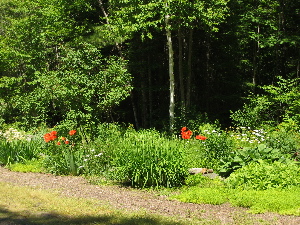SNOW ON SHRUBS AND TREES
It's been a few years since we've seen this amount of snow! I can't say I'm not enjoying it. This is part of why I live in the North Country.
As far as the garden is concerned, the snow provides a good, stabilizing cover for everything. It acts as a mulch, protecting the ground from the heaving frosts. That's a good thing. The bad thing about this much snow is that it can become a very heavy burden for trees and shrubs. The branches are often pushed to their breaking point and hence we see a lot of broken branches in the spring. We can help with this. It's a good thing for us to get out into the fresh air anyway, so let's be productive when we can.
Bundle up, grab a rake or broom (or something with a long, skinny handle) and go out in the garden. When you see branches heavy-laden with snow, poke the handle end of the broom into the bush pushing the branches gently to dislodge the snow. As long as ice hasn't formed, the snow will dislodge and spill to the ground. The branches will pop up gratefully! You should do this as often as you can BEFORE ice has a chance to form.
Once ice has formed, I would suggest that you forgo this process. When you push on the branches they will more than likely break. Leave them alone and hope for the best! Remember, in nature, bushes and trees don't have someone doing this for them. It's a kind of natural pruning technique...but not one that is particularly neat, or good for the plant! Broken branches, besides looking bad, are magnets for disease and insect "invasion".
As you can see, we can't ignore the garden entirely during winter. It will still benefit from our stewardship!




